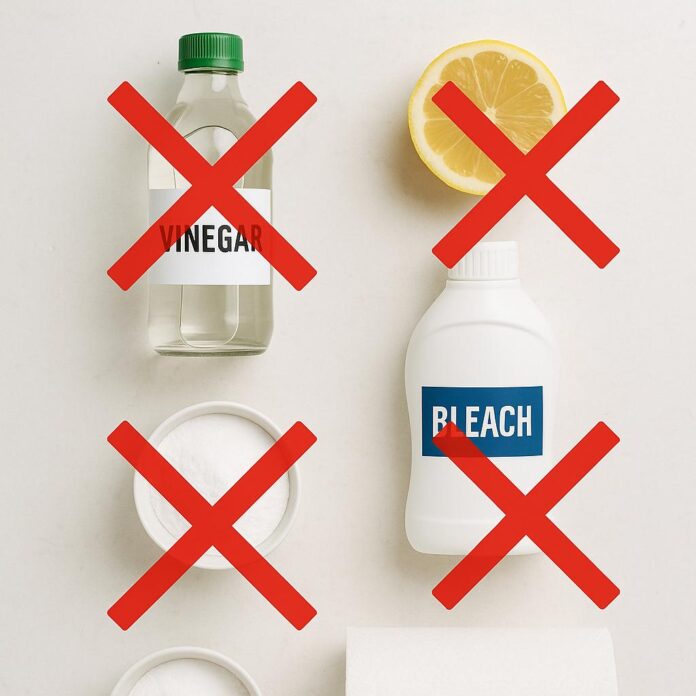When it comes to house cleaning, we often think that anything labeled “clean” or “safe” will work on every surface. The truth is, many everyday items and “life hacks” you find online can actually do more harm than good. Using the wrong products or tools may damage furniture, scratch surfaces, or even pose health risks.
In this guide, we’ll highlight 10 common household items you should avoid using for cleaning, explain why they’re harmful, and suggest better alternatives. By avoiding these mistakes, you’ll keep your home cleaner, healthier, and long-lasting.
🚫 1. Vinegar on natural stone

Why it’s harmful: Vinegar is acidic. While it’s a great natural cleaner for many surfaces, it can etch and dull natural stone like marble, granite, and limestone.
Better alternative: Use a pH-neutral stone cleaner or simply warm water with mild dish soap.
🚫 2. Bleach on wooden surfaces

Why it’s harmful: Bleach is highly corrosive and can strip wood finishes, leaving permanent stains or cracks.
Better alternative: Opt for a wood-safe cleaner or a mix of water and vinegar (in very diluted amounts) for hardwood floors.
🚫 3. Baking soda on glass surfaces

Why it’s harmful: Baking soda is abrasive. While useful for scrubbing, it can scratch glass oven doors, mirrors, or windows.
Better alternative: Use vinegar spray followed by a microfiber cloth.
🚫 4. Paper towels on screens

Why it’s harmful: Paper towels may look soft, but they contain wood fibers that can scratch TV screens, laptops, and phone displays.
Better alternative: Use a microfiber cloth.
🚫 5. Furniture polish on kitchen countertops

Why it’s harmful: Polish often leaves a greasy film that attracts dust and bacteria—especially dangerous in food preparation areas.
Better alternative: Clean with warm water and dish soap or a kitchen-safe disinfectant.
🚫 6. Lemon juice on metal fixtures

Why it’s harmful: Lemon juice can corrode brass, copper, and chrome. Instead of shining, your faucets might end up with dull spots or discoloration.
Better alternative: Use a metal-specific cleaner or simply warm water.
🚫 7. Too much water on wooden floors

Why it’s harmful: Excess water can seep into wood grains, causing swelling, warping, and mold growth.
Better alternative: Lightly dampen a microfiber mop with a wood-safe cleaner.
🚫 8. Harsh chemicals on stainless steel

Why it’s harmful: Strong cleaners and chlorine can strip away the protective coating of stainless steel, leading to rust.
Better alternative: Use a mix of vinegar and water or special stainless-steel sprays.
🚫 9. Ammonia on mirrors

Why it’s harmful: While ammonia can leave glass shiny, it also damages mirror backing over time, causing dark “black spots.”
Better alternative: Use a vinegar and water spray or commercial glass cleaner.
🚫 10. Toilet bowl cleaners on other surfaces

Why it’s harmful: These cleaners are too strong for sinks, bathtubs, or tiles and can strip finishes or leave stains.
Better alternative: Stick to multi-surface cleaners for areas outside the toilet.
✅ General cleaning safety tips
- Always read product labels before using.
- Test cleaners on a small, hidden area first.
- Use gloves and ventilation when working with strong chemicals.
- Don’t mix products like bleach and vinegar—they release toxic gases.
Conclusion
Good cleaning isn’t just about effort—it’s about using the right tools and products. By avoiding these 10 mistakes, you’ll protect your home surfaces, save money, and keep your environment healthier.
Next time you reach for vinegar, baking soda, or bleach, remember: not every “hack” is safe for every surface. Choose wisely, and your home will thank you.



